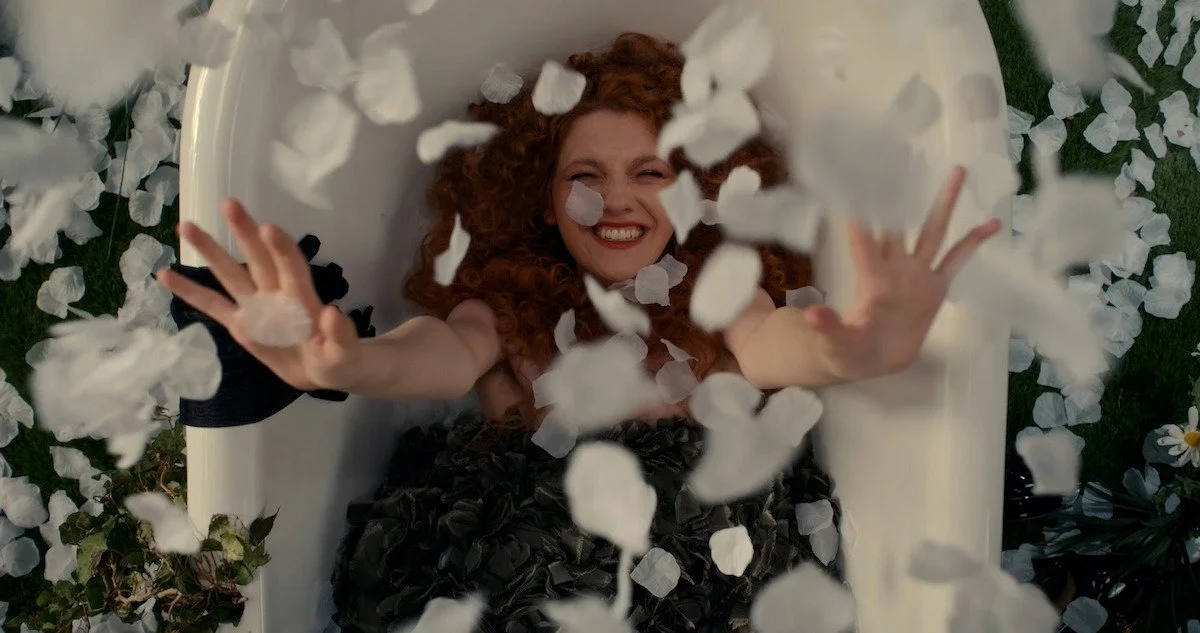Geek Glamour Glory
As always, and as never before, we live once upon a time, here and now. The story of Harriet Manners in the Netflix series Geek Girl (2024) may be an indication of how the fairy tale contributes to our understanding of fashion – an otherworldly and all-too-real realm of self-making.
Harriet Manners (portrayed by Emily Carey) is living the Yuji Lee essence. Looking very much like a fairy, and lying mere feet away from the boy she describes as her Prince, Harriet awakens to the dream of becoming a character in her own right. Available via Netflix Tudum. © All rights belong to their respective owners. No copyright infringement intended.
Not Very Far Away and Not Too Long Ago…
The Netflix series Geek Girl (2024), based on Holly Smale’s homonymous books, aired on our home screens in 2024. The series was produced by Zoë Rocha (the daughter of a prominent Irish fashion designer), and so it’s no surprise that Geek Girl is renowned for its first-hand insights on fashion (The Gloss). Additionally, it has been lauded for its ethical approach to representing neurodiversity (BBC). But above all else, Geek Girl has been celebrated as a fairy tale (BBC Breakfast).
And it’s not just a fairy tale: it’s a modern re-take. As a writer, Holly Smale aspired to renovate the traditional, patriarchal form of storytelling: “The idea is not to replace flawless one-dimensional fairytale heroines with brand new flawless one-dimensional feminist heroines, who do everything brilliantly and are in total control and never show any weaknesses,” Smale clarifies (The Guardian). “What I’m really aiming for with my writing [is] replacing the perfect fairytale princess with an imperfect, real girl who picks her own adventure, finds her own strength and courage, and recognises her own sense of self”.
So what is the Geek Girl fairy tale? And more importantly, how does it speak to our vision and experience of fashion?
As it happens, fashion is quite similar to narrative-building; it is woven and communicated into being. Fashion emerges through a technology very similar to writing, with fabric for paper and stitches for letters or sounds. Whether spoken or written, all fairy tales index the archetypal storyteller – the woman. It’s the old crone, the grandmother, the mother, and the spinster who produce fairy tales and enchant us with their magic. In Geek Girl, Harriet is both character and narrator. Her voice is driven by “who she is” and “what she does”, just like any other fairy tale persona. Her voice is also unique and lends the picture a flavourful force that distinguishes it from any other weaver of tales. But Harriet’s story emerges through other female narrators, too. For example, Yuji Lee herself. In fact, it isn’t always clear which of the two – Harriet or Yuji – imparts her essence to the other. With a red thread in her hands, Yuji finishes Harriet’s show-stopper dress, literally embroidering the finale of this short autobiography. And we must not forget the teenager’s best friend Nat. Her original hot-pink gown with ink-black print makes a highly successful debut at the BASCAR event. Nat’s masterpiece carries the geek to the gates of glamour.
Fashion also recalls other narratives that came before and continue to swarm around us. Fashion is intertextual. The fairy tale lives on in fashion because fashion lives on by retelling and reinterpreting the fairy tale. Geek Girl is a vivid illustration of this. By holding on to the stories we’d all heard as children, and by harnessing familiar heroes and motifs, the series underscores the scope of fashion as a depository of social and cultural experiences. Whenever Harriet is bullied by the more fashionable pupils and whenever she falls face flat on the floor, she bears her cross like a Hiccup or a Fishlegs from Cowell’s HTTYD series. When Harriet is astonished at being ‘discovered’, she stares with the incredulous eyes of Harry Potter at her Hagrid benefactor Wilbur Evans. When Harriet grapples with the painful competitiveness of her colleagues, she bears it with the stoicism of Cinderella. When Harriet soars to triumph at the BASCAR show, hers is a flight of the transformed Ugly Duckling. Harriet extends the legacy of wonder tales “for anyone who’s ever wanted to be someone different. And I’m guessing that’s most of us. It isn’t a makeover… it’s a full metamorphosis” (Geek Girl). Like fairy tales, fashion transcends normativity, always pointing to new horizons of revolution and outrage. At the same time, fashion is a ballad to everyday heroism that throws together the bland and the spicy: the blue tainted school bag and the blue canvas at the runway podium; baggy uniform and frilled black drapery; cyberbullying and good press; tight spidery overalls and slim mermaid contour.
For Harriet Manners, fashion is indeed all about making. Making stories. Making the materials to tell those stories. Making the person – the self – who wears them. Fashion is a paradigm which, with its toil, trouble, discomfort, insecurity, fame, elegance, and eloquence, brings about the emergence of self-knowledge. The Geek Girl fairy tale is a narrative which informs our idea of fashion as something both tangible and imperceptible; strenuous and magical; humble and abundant. Fashion is a bed in which the person is conceived and delivered. Fairy tale is the frame of that bed. Fairy tale chisels fashion; fashion embellishes the fairy tale. After all, it seems that the fairy tale is the most fashionable way of making sense.

